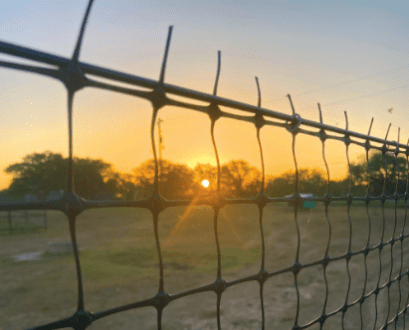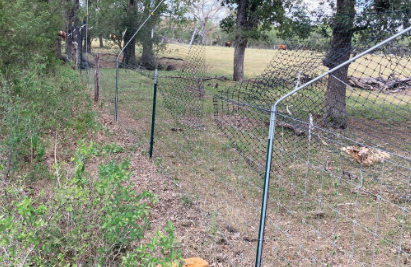
Dec 12, 2022Protecting orchards from deer damage
Because they consume lots of fruits and pecans, deer can become big problems in orchards, especially during mating season when male deer can destroy trees.
Monte Nesbitt, Extension program specialist of pecans, fruit and citrus at Texas A&M AgriLife Extension Service in College Station, discussed his experiences keeping deer away from his peach orchard south of Gonzalez, Texas, at the Sept. 26-27 Texas Fruit Conference in New Braunfels.
He and his wife purchased land across the road from his parents east of San Antonio. They planted 100 trees on one parcel and 70 trees on another on their 6 acres.
“Deer are a real challenge,” Nesbitt said. “Peaches are challenging enough without the added burden of deer browsing and scraping. It’s been a real, real serious negative impact on my ability to be successful growing fruit trees the way I want to. You train your plants, you fertilize, you spray, but lose a tree to a male deer that needs to find something else to do with his time. It’s not a pleasant situation.”
Deer tree battles
From September through January, male deer fight each other with their antlers and love to practice their fighting skills on peach trees.


“They like to scrape, rattle and just feel really big,” Nesbitt said. “Peaches are labor intensive enough, with tree training, thinning, weed control and fertilizer. What you don’t need is the added burden of having deer browsing, eating the foliage, robbing the carbohydrate accumulation process or strangling the young trees to death or injuring your mature trees.”
States with the highest whitetail deer populations include Texas, at 5.4 million, Michigan, 2 million, Alabama, 1.8 million, Missouri, 1.4 million, Georgia, 1.3 million, New York, 1.2 million, and North Carolina, 1 million. During the fall of 2016, 22%of his first 100 trees saw moderate or severe deer scraping damage.
Getting past the deer by erecting a fencing system opened a new realm of possibilities for Nesbitt and his time, he said.
Nesbitt went through the various types of solutions. He characterized electric fences as possessing positives and negatives, but stated they can help, at least a little.
Electric systems thwart some damage, not only from deer, but also raccoons and opossums. Deer quickly learn if the fence is hot or not. Electric fences are relatively low cost and can expand to or reduce areas quickly as needed. They must be in clean, weed-free areas. Erection in open and unobstructed areas work best, Nesbitt said.
A big headache, however, is constant “grounding out.” Something as small as a blade of grass can negate the system, Nesbitt said. “It just takes one thing to go wrong, and your defense system is out of order,” he said. “I’ve found you must live onsite to monitor the soap opera of you grounding out every day.”
Individual tree enclosures, such as posts and fencing using chicken wire and web mesh, can be highly effective against an array of large and small animals, and work well in small and recreational scale orchards. Such systems, however, are more expensive than fencing the perimeter in commercial orchards. A grower could spend more money on individually protecting the trees rather than erecting a strong commercial fence surrounding the orchard’s perimeter in commercial scale orchards, Nesbitt said.
Predator protection
A number of effective solutions are available to protect against many large and small predators include bags, nets and cages. One netting application protects against hail, insects and birds, including Japanese beetles and stink bugs. While simple to install, a major con is interference with many orchard tasks such as weeding, pruning and thinning.
A variety of repellents, including insecticides, aromatics, blood-based, predator urine, human odors including hair and dusting sulfur, offer variable endurance, expense and effectiveness.


Kaolinite clay, an OMRI/organic culture approved particle film, can be good for deer and insect prevention, particularly with weevils, curculios and stink bugs. However, rain washes the product off fruit.
An 8-foot high game fence works immediately. However, at $14 a foot, it could add up to a $35,000 investment to serve a 2,550-linear foot perimeter (in 2017).
A cheaper fence made from lightweight plastic which can cost from 62 cents to $1.16 a foot, about half the cost of a regular high fence. Low fence construction, including materials, installation and brush removal, was $5.35 a foot, according to Nesbitt’s presentation.
Whatever option, be prepared to invest in quality equipment, he said.
If fencing seems too expensive, Nesbitt recommends growing something deer won’t eat, like pomegranates and figs, which may also possess some deer resistance.
Elaborate electrical systems are expensive, but can be effective, he said.
“There are some really robust electrical fencing systems out there,” Nesbitt said. “You can spend money on them and can get out of them what you put into them.”
Nesbitt and his wife Carole planted their first crop in 2015 and harvested their first commercial peach crop in 2018.
— Doug Ohlemeier, assistant editor
Top photo: Fencing can help protect orchards from deer, which can damage trees. High game fences work well but are costly. Photos: Monte Nesbitt
Middle photos: Individual tree enclosures can be effective against small and large animals.
Bottom photo: A variety of fencing to protect orchards from deer, which eat fruits and nuts, is available.














